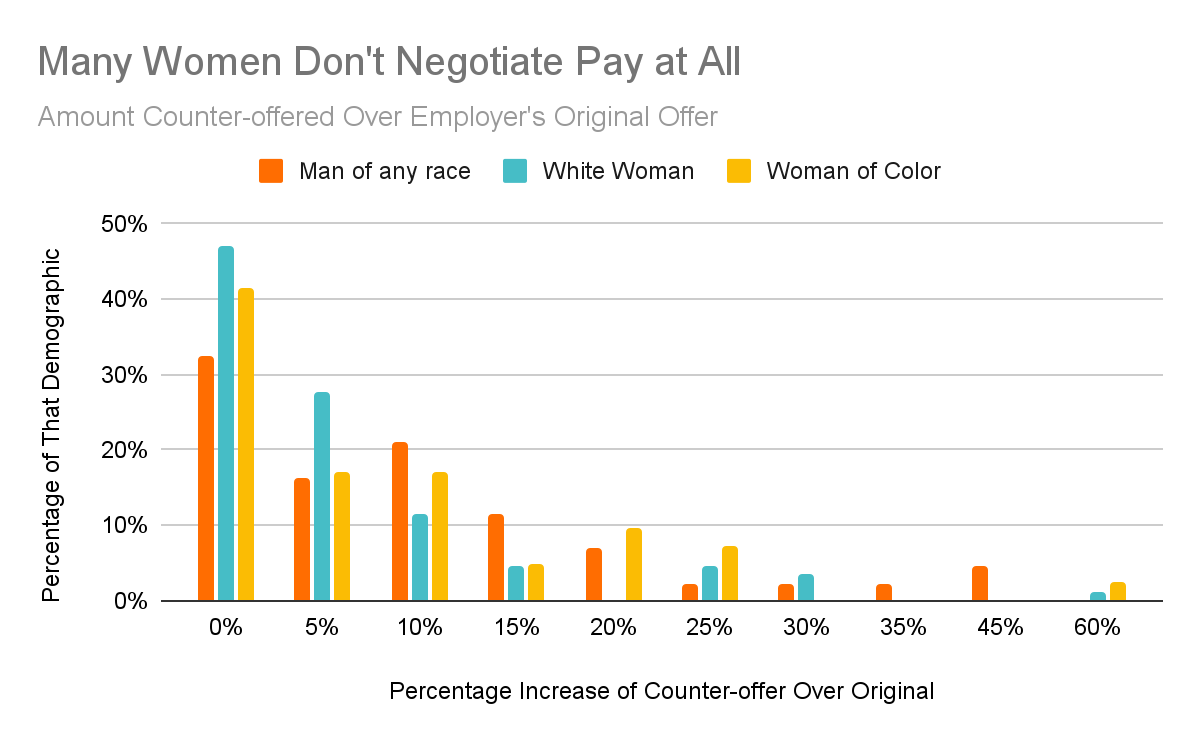Impact of Negotiation on Pay Equity & What You Can Do About It
Last fall Co-Founder Cassie Schmitt participated in Women In Data’s Datathon with Kelly Dunn and Han Song. The datathon provided awareness, education, and recommendations for how we can improve women’s equality in the workplace.
The gender pay gap exists across almost every profession around the world. In the United States, for every dollar white, non-Hispanic men earned in 2020 women earned between 55 cents to 87 cents. The team asked the question:
“How does negotiation during the hiring process affect the gender pay gap?”
Based on our research, we conducted a short survey to investigate our question. We used Google Forms and asked 14 questions. We shared the survey via our professional networks and on social media. The 175 respondents were 49% white women, 24% women of color, 24% men, and 4% non-binary.
Three key findings around pay equity and negotiation
Women don’t negotiate as often or as hard
Women were less likely to counteroffer the original salary offer than men. Over 40% of white women and women of color did not counter-offer at all. When women did negotiate and counteroffer a salary, they were less aggressive than men. Out of the 50% of the women who did negotiate, they countered less than 10% over the initial offer. Only a third of men countered that low.
Men on average asked for the highest increase.
Women ask for less if a salary range was available
Women asked for somewhat less when the salary range is posted in the job ad. A posted salary doesn’t seem to affect men’s negotiation strategy.
Caveat: The survey did not ask how the original offered compared to the posted salary range. We need more information to better understand the effect of knowing a salary range before negotiating.
Average amount counter-offered over the original offer among women and men who negotiated.
Negotiating can raise salary offers
All respondents by gender and race were about equally likely to get the salary they asked for. This graph shows the amount of the employer’s final offer as a percentage of what the candidate asked for.
100% means the candidate got what they asked for in a counter offer.
Other factors contributing to negotiating success
People with less than 2 years of experience countered less than those with more experience.
Only two out of 175 respondents said they had a job offer rescinded when they tried to negotiate.
When the candidate expresses a desired salary up front, the negotiation may be slightly less successful, but the difference was not statistically significant.
Recommendations for Employers Who Care About Pay Equity
Employers can put processes in place to improve pay equity for their employees.
During the hiring process
Post the hiring range
Do not ask for desired or past salaries
Share information with candidates about how your organization develops salary offers
Educate recruiters in understanding how bias can affect their response when a candidate negotiates
Outside of the hiring practice
Gather & analyze negotiation data for inequitable outcomes. If you discover disparities between different groups
Look for ways to improve hiring practices for new employees
Conduct pay equity studies for current employees on a regular basis and make adjustments when needed
Recommendations for Individuals Negotiating Salary
Counter the first offer
Ask for more than you think you should
Don’t let a posted salary range stop you from negotiating your salary
Take Cindy Gallop's advice to heart:
"The amount you ask for is always the highest amount you can say out loud without actually bursting out laughing"
Further Study Ideas
The Datathon schedule meant we limited this study in duration and audience. There is so much more to explore on this topic. A few ideas include:
Negotiating non salary benefits like more time off, flexible schedule, etc...
Impact of intersectionality including data on women of different races, gender identities, sexual orientations, and economic status
Difference in women-dominated industries or roles
Impact of salaries posted in job descriptions and practices of asking for desired salary
Get in touch for help with
Integrating salary information into job ads
Implementing data collection and analysis of hiring and salary data
Pay equity studies
Or you want to partner with us on another idea around pay equity
Contact us to work together or sign up for our newsletter.


